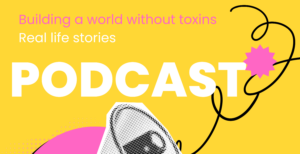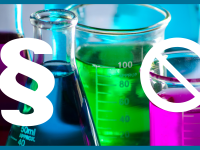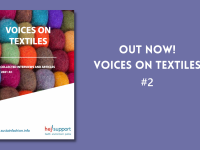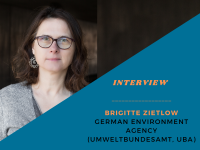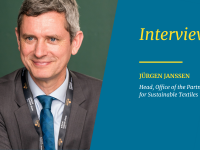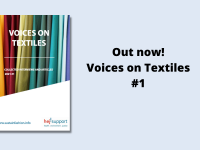Interview with Dr. Tadesse Amera – Director of PAN Ethiopia and Co-Chair of IPEN

Amelie Owen (HEJSupport) sat down with Dr. Tadesse Amera to discuss the challenges and benefits of the transition to organic cotton farming in Ethiopia.
Could you tell me a bit more about yourself? When and why did you decide to start growing organic cotton?
My organization Pesticides Action Network (PAN) Ethiopia works in mitigating the environmental and health impacts of pesticides and other hazardous chemicals. When talking about pesticides, most of the world’s production is used for cotton growing. Indeed, cotton is also known as a “museum of pests” because it attracts many pests. When pesticides are used (most of them very hazardous), it affects the producers, health and especially the smaller farmers but also the environment. Most reports of pesticides poisoning come from cotton fields because the majority of pesticides are used there. The main goal of my organization is to reduce the burden of pesticides on smallholder farmers.
Could you tell me about your work on the implementation of cotton organic farming?
We started with introducing a integrated pest management (IPM) approach in southern Ethiopia in the Rift Valley Area. The IPM) approach means that one is using techniques that focus on pest prevention without the use of synthetic pesticides. Synthetic pesticides are expensive and dangerous for people’s health while biological control measures are proved to be effective and affordable for the local communities. Our trainings were useful as many farmers recognized that they did not need synthetic pesticides at all and decided to start organic cotton farming instead. This is how our first and unique, for now, organic cotton farm cooperative was set up in Ethiopia.
What kind of obstacles did you face in the transition to organic farming?
The main obstacle was the first steps in the introduction of the IPM approach which was not like the usual practice, which needed an adult learning approach and farmer field schools to get behavior change. But after we accomplished these first steps, it was the farmers’ initiative to transition themselves to organic farming.
Introducing techniques that assist minimizing pesticide dependency via IPM practice was a challenge because behaviors have to be changed and a new way of proceeding has to be learned. We used, for that purpose, the farmers field school approach to bring the behavioral change. The farmers field school is a method that makes farmers experts and involved as part of the knowledge sharing process rather than acceptors of “top-down directives”.
Why is organic farming of cotton necessary in the matter of the textile industry?
The textile industry is trying to source 100% sustainable cotton by 2025. One of the sustainable cotton categories is organic. For some industries that want to go organic, the organic farming is an input that they need to have. By getting organic cotton, the industry can go all organic through the value chain: organic dyes, environmentally-sound production systems but also respecting social rights of employees. They become an ethical industry. Thus, organic farming is indeed a good input for the industrial sector.
Could you explain what are the specific issues related to women field workers? Are women more easily exposed to health threats in cotton production?
With regards to pesticide poisoning, women are really in danger. There is numerous scientific data confirming toxic effects of pesticides on women, including breast cancer and lower fertility. However, exposure to pesticides affects more than just the health of women themselves. There is also a risk of toxic chemical transmission to the womb. For that matter, the newborn can also be exposed. In addition, women working in the farms can wear clothes contaminated with pesticides, which will end up in the household where the contamination continues.
These and other threats posed by pesticides are an important argument in favor of organic farming, including organic cotton production. We brought this to the attention of working women, and they were among the first farmers to support the idea of organic cotton production. Since then, women have played a big role in our cooperative.
What is the key market for your organic cotton?
The demand so far has been in different parts of the world. Since the production is absorbed by the Ethiopian textile industry, the cotton is sold to the national sector which exports the textile products further.
With regards to textile production, our women farmers have hand spinning associations that produce hand-spun yarn (see photo below) and this yarn is hand-woven to produce traditional dresses in small numbers.

Is it difficult to be certified as organic cotton?
It is a very difficult and long process where every step of the production must be documented. But now the farmers have the EU Organic certification for the whole cooperative.
What kind of monitoring have you set into place to ensure the organic farming standards are followed?
We have experts in the field which are assisting the farmers in their daily activities. Moreover, there is an internal control system within the cooperative which is managed by the farmers themselves. We assist the farmers, and the farmers have a peer monitoring system according to the internal system that they developed themselves.
What are the next steps in organic cotton farming in Ethiopia?
Our work depends on funding, and the COVID-19 pandemic has significantly affected the availability of funds. However, we plan to expand our work to other parts of Ethiopia so that more farmers start producing organic cotton and more textile producers turn to using organic raw materials for fabrics and clothing. I believe that Ethiopia could be a great example for other African countries and the world to produce cotton that is safe for people and the environment.
